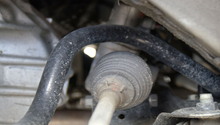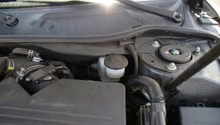Toyota Camry: How to Change Power Steering Fluid
Much like engine oil and brake fluid, power steering fluid breaks down over time and should be serviced. Keep your hydraulic power steering happy with fresh fluid.
This article applies to the Toyota Camry (1997-2011).
Much like your brakes, the steering system in your Toyota Camry is hydraulically-powered. This means that fluid circulates in the system to assist in turning the steering wheel. Without the assistance of power steering, the steering wheel would be much heavier in feel, and more difficult to turn. Again, much like brake fluid, excessive usage, or high temperatures can lead to reduced performance as the oil inside the system breaks down. If the fluid breaks down past the point of effectiveness, you may lose steering assistance, and have reduced steering performance. Fortunately, servicing the power steering fluid is about as easy as it gets, and power steering fluid is readily available and inexpensive. With that said, consider doing this quick touch up service bi-annually to keep your power steering happy and healthy.

Materials Needed
- Turkey baster, syringe or other suction device
- Power steering fluid
- Jack and jack stands (optional)
- Paper towels (optional)
Step 1 – Remove all fluid from reservoir
Locate the power steering reservoir in the engine bay of your Camry. The reservoir is mounted on the right fender (passenger side), in between the coolant overflow reservoir and the strut tower.
Unscrew the cap on the reservoir and use your suction device to extract the old fluid from the reservoir. While the reservoir is mostly "dry," consider using your paper towels to give the it a small wipe down, as grime does accumulate on it.
Once as much old fluid has been extracted as is possible, refill the reservoir to the "full" line with fresh fluid.

Pro Tip
If you lack a disposal container for it, old power steering fluid can be mixed with old motor oil for disposal in a pinch.
Step 2 – Cycle the power steering
With the cap twisted back onto the reservoir, start your vehicle and slowly spin the steering wheel from lock to lock several times.
This is where you would use the jack and stands to lift and secure the front end of the vehicle to reduce the friction of the tires being on the pavement.

Figure 2. Lift the front wheels into the air. 
Figure 3. Spin the wheel from lock-to-lock.
Step 3 – Check power steering fluid
By cycling the system, you've pushed the new fluid into the system, and some old fluid has been pushed into the reservoir. Suction this out, much like you did in Step 1, and refill with new fluid.
Step 4 – Repeat Steps 1 through 3 until fluid comes out clean
Repeat the cycle of checking and adding fluid, turning the wheel lock-to-lock, and checking the reservoir again, until the fluid in the reservoir comes out clean. Once the power steering fluid comes out fresh and clean, do a quick "bleed" of the system by removing the reservoir cap and spinning the steering wheel lock to lock several times again to push any air out of the system through the open reservoir cap. With that, you are done.
Lower the vehicle down if you set it on stands, and take a test drive around the block to ensure that the steering is quiet and smooth.
How to Change Power Steering Fluid
Related Discussions
- Power Steering - Camryforums.com
- 2005 Camry Power Steering Fluid - Camryforums.com
- Power Steering Reservoir Overfill - Camryforums.com
- Power Steering Fluid Leak - Camryforums.com
- Using ATF Instead of Power Steering Fluid - Camryforums.com






